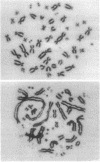Abstract
Cultured lymphocytes exhibiting extreme cytogenetic damage (rogue cells) were observed in preparations from 8 of 24 individuals sampled in Krasilovka, a Ukrainian village receiving little or no increased radiation after the Chernobyl disaster, but were not observed in an additional 24 persons from two Russian towns in the more contaminated area. This observation cements the worldwide occurrence of these cells. The present data plus a review of the literature establish that rogue cells appear in brief bursts simultaneously in certain individuals of discrete populations. We suggest that the pattern is consistent with the action of a viral trigger that acts directly or indirectly--the latter possibly through the activation of latent chromosomal retroposons. If this phenomenon occurs in other tissues, it may have important implications for oncogenesis, teratogenesis, mutagenesis, and evolution.
Full text
PDF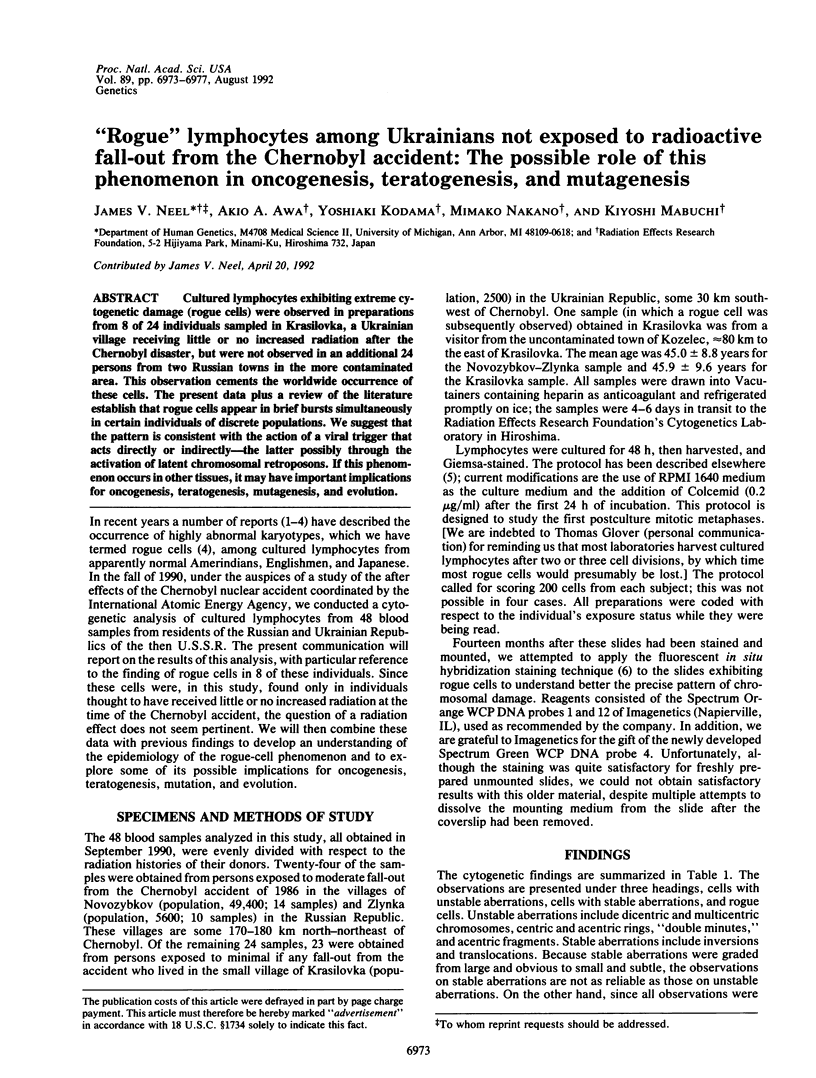
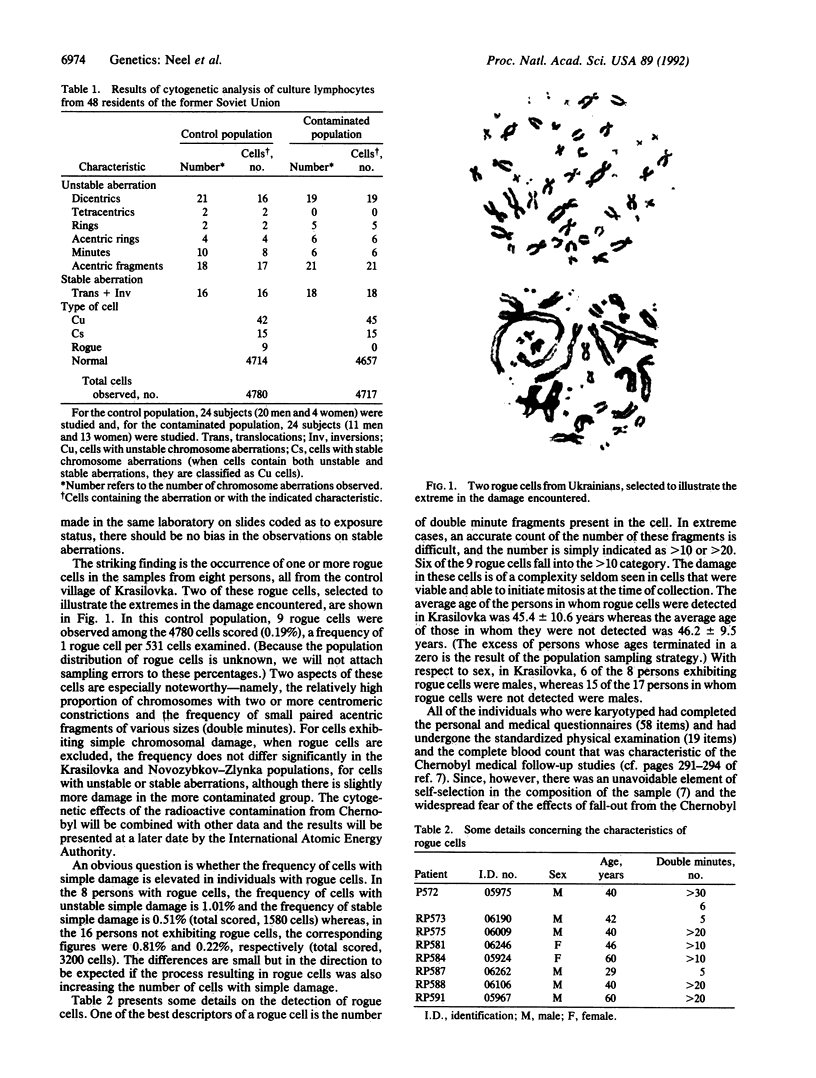
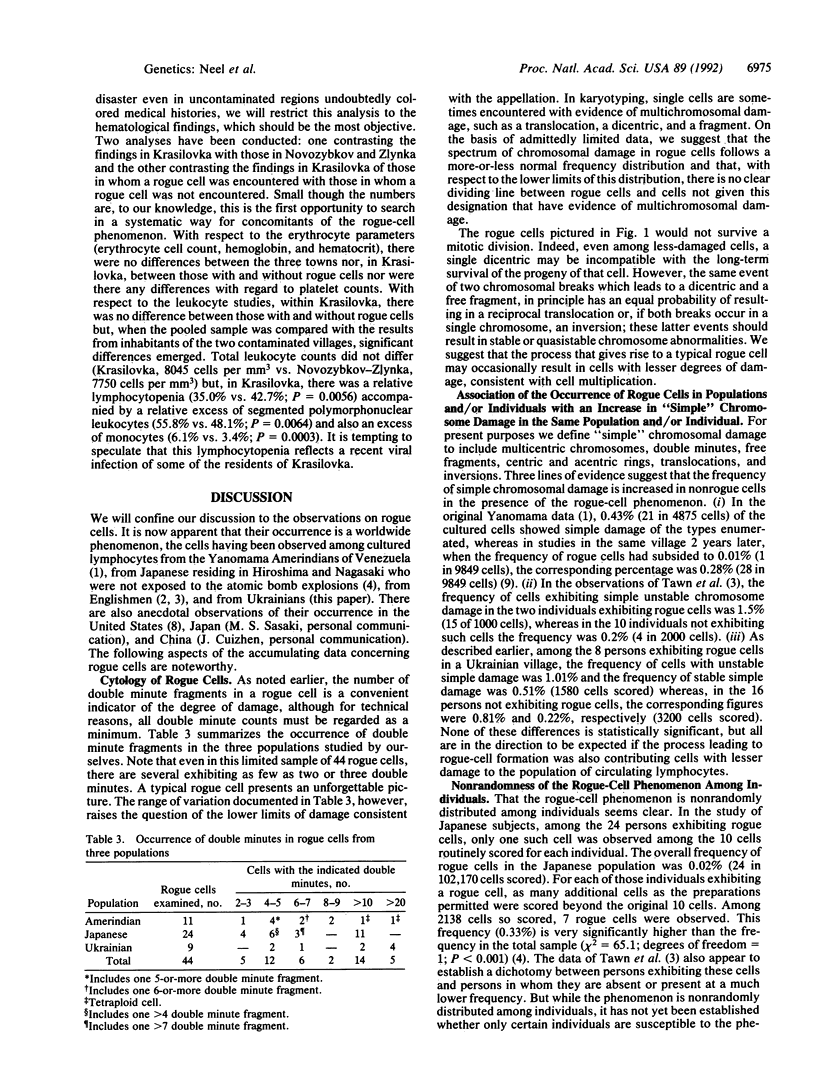
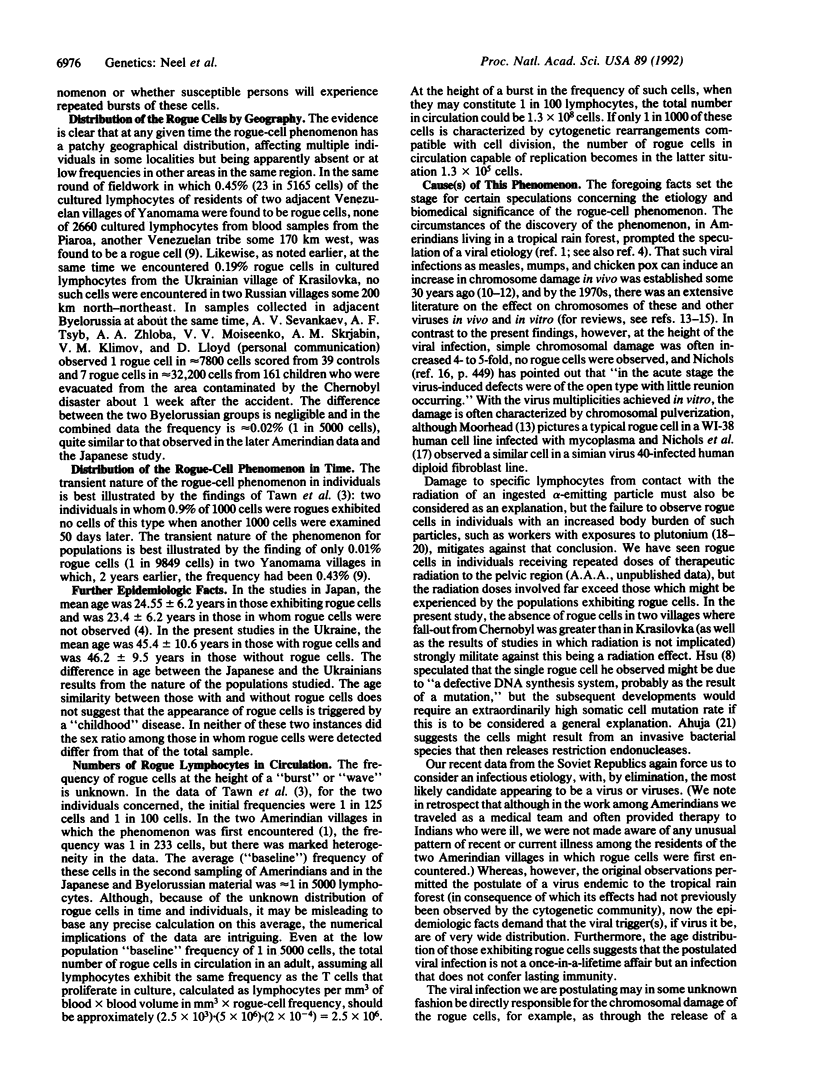
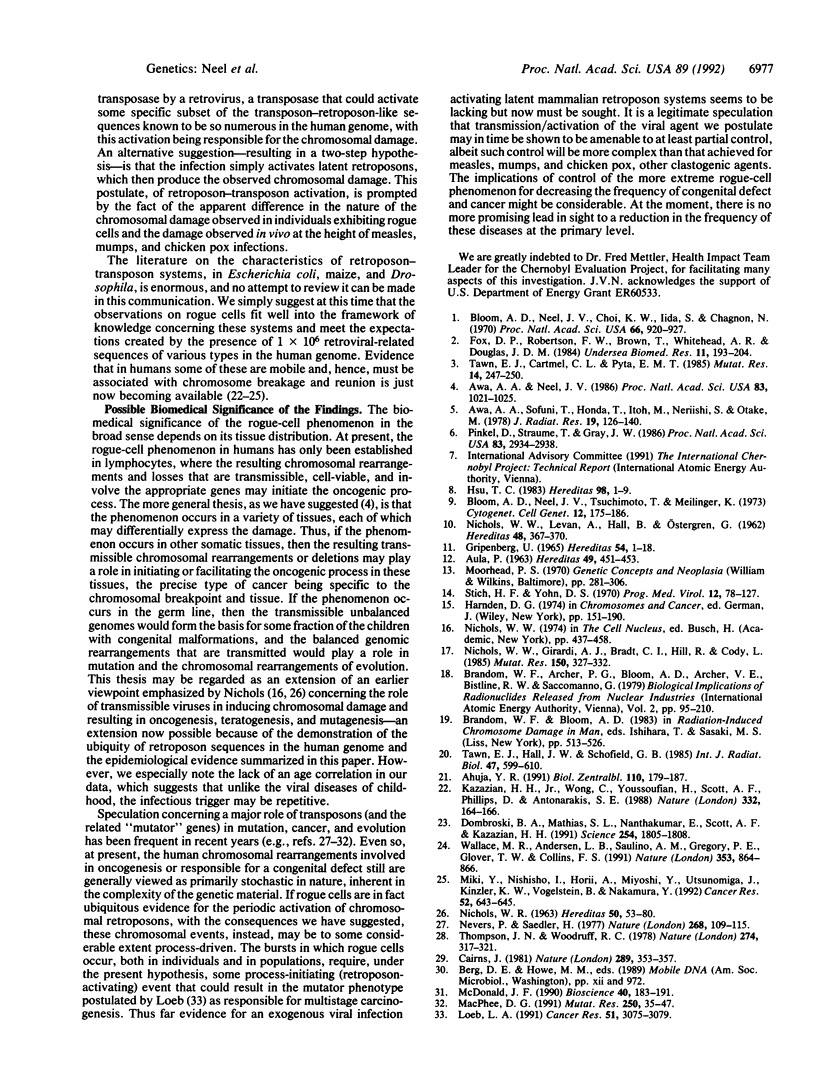
Images in this article
Selected References
These references are in PubMed. This may not be the complete list of references from this article.
- Awa A. A., Neel J. V. Cytogenetic "rogue" cells: what is their frequency, origin, and evolutionary significance? Proc Natl Acad Sci U S A. 1986 Feb;83(4):1021–1025. doi: 10.1073/pnas.83.4.1021. [DOI] [PMC free article] [PubMed] [Google Scholar]
- Awa A. A., Sofuni T., Honda T., Itoh M., Neriishi S., Otake M. Relationship between the radiation dose and chromosome aberrations in atomic bomb survivors of Hiroshima and Nagasaki. J Radiat Res. 1978 Jun;19(2):126–140. doi: 10.1269/jrr.19.126. [DOI] [PubMed] [Google Scholar]
- Bloom A. D., Neel J. V., Choi K. W., Iida S., Chagnon N. Chromosome aberrations among the Yanomamma Indians. Proc Natl Acad Sci U S A. 1970 Jul;66(3):920–927. doi: 10.1073/pnas.66.3.920. [DOI] [PMC free article] [PubMed] [Google Scholar]
- Bloom A. D., Neel J. V., Tsuchimoto T., Meilinger K. Chromosomal breakage in leukocytes of South American Indians. Cytogenet Cell Genet. 1973;12(3):175–186. doi: 10.1159/000130453. [DOI] [PubMed] [Google Scholar]
- Cairns J. The origin of human cancers. Nature. 1981 Jan 29;289(5796):353–357. doi: 10.1038/289353a0. [DOI] [PubMed] [Google Scholar]
- Dombroski B. A., Mathias S. L., Nanthakumar E., Scott A. F., Kazazian H. H., Jr Isolation of an active human transposable element. Science. 1991 Dec 20;254(5039):1805–1808. doi: 10.1126/science.1662412. [DOI] [PubMed] [Google Scholar]
- Fox D. P., Robertson F. W., Brown T., Whitehead A. R., Douglas J. D. Chromosome aberrations in divers. Undersea Biomed Res. 1984 Jun;11(2):193–204. [PubMed] [Google Scholar]
- Gripenberg U. Chromosome studies in some virus infections. Hereditas. 1965;54(1):1–18. doi: 10.1111/j.1601-5223.1965.tb02003.x. [DOI] [PubMed] [Google Scholar]
- Hsu T. C. Genetic instability in the human population: a working hypothesis. Hereditas. 1983;98(1):1–9. doi: 10.1111/j.1601-5223.1983.tb00574.x. [DOI] [PubMed] [Google Scholar]
- Kazazian H. H., Jr, Wong C., Youssoufian H., Scott A. F., Phillips D. G., Antonarakis S. E. Haemophilia A resulting from de novo insertion of L1 sequences represents a novel mechanism for mutation in man. Nature. 1988 Mar 10;332(6160):164–166. doi: 10.1038/332164a0. [DOI] [PubMed] [Google Scholar]
- Loeb L. A. Mutator phenotype may be required for multistage carcinogenesis. Cancer Res. 1991 Jun 15;51(12):3075–3079. [PubMed] [Google Scholar]
- MacPhee D. G. The significance of deletions in spontaneous and induced mutations associated with movement of transposable DNA elements: possible implications for evolution and cancer. Mutat Res. 1991 Sep-Oct;250(1-2):35–47. doi: 10.1016/0027-5107(91)90160-p. [DOI] [PubMed] [Google Scholar]
- Miki Y., Nishisho I., Horii A., Miyoshi Y., Utsunomiya J., Kinzler K. W., Vogelstein B., Nakamura Y. Disruption of the APC gene by a retrotransposal insertion of L1 sequence in a colon cancer. Cancer Res. 1992 Feb 1;52(3):643–645. [PubMed] [Google Scholar]
- Nevers P., Saedler H. Transposable genetic elements as agents of gene instability and chromosomal rearrangements. Nature. 1977 Jul 14;268(5616):109–115. doi: 10.1038/268109a0. [DOI] [PubMed] [Google Scholar]
- Nichols W. W., Girardi A. J., Bradt C. I., Hill R., Cody C. Cytogenetic changes induced in human diploid fibroblasts by tsA58 SV40 at permissive and restrictive temperatures. Mutat Res. 1985 Jun-Jul;150(1-2):327–332. doi: 10.1016/0027-5107(85)90129-0. [DOI] [PubMed] [Google Scholar]
- Pinkel D., Straume T., Gray J. W. Cytogenetic analysis using quantitative, high-sensitivity, fluorescence hybridization. Proc Natl Acad Sci U S A. 1986 May;83(9):2934–2938. doi: 10.1073/pnas.83.9.2934. [DOI] [PMC free article] [PubMed] [Google Scholar]
- Sitch H. F., Yohn D. S. Viruses and chromosomes. Prog Med Virol. 1970;12:78–127. [PubMed] [Google Scholar]
- Tawn E. J., Cartmel C. L., Pyta E. M. Cells with multiple chromosome aberrations in control individuals. Mutat Res. 1985 Dec;144(4):247–250. doi: 10.1016/0165-7992(85)90059-4. [DOI] [PubMed] [Google Scholar]
- Tawn E. J., Hall J. W., Schofield G. B. Chromosome studies in plutonium workers. Int J Radiat Biol Relat Stud Phys Chem Med. 1985 May;47(5):599–610. doi: 10.1080/09553008514550831. [DOI] [PubMed] [Google Scholar]
- Thompson J. N., Jr, Woodruff R. C. Mutator genes--pacemakers of evolution. Nature. 1978 Jul 27;274(5669):317–321. doi: 10.1038/274317a0. [DOI] [PubMed] [Google Scholar]
- Wallace M. R., Andersen L. B., Saulino A. M., Gregory P. E., Glover T. W., Collins F. S. A de novo Alu insertion results in neurofibromatosis type 1. Nature. 1991 Oct 31;353(6347):864–866. doi: 10.1038/353864a0. [DOI] [PubMed] [Google Scholar]



